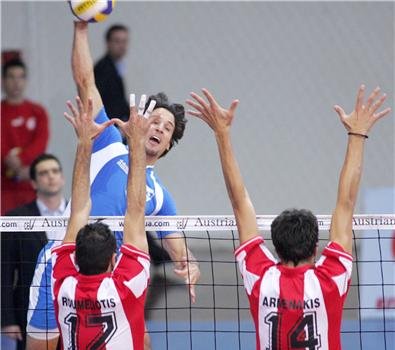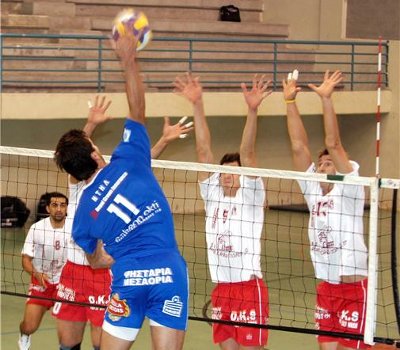 Volleyball Spike with Mike Diehl. Hi, I’m Mike Diehl, fifteen year indoor volleyball pro including three time league MVP, league kill leader and league ace leader. Also Bud 4-man beach tour MVP, kill leader and NCAA Champion at UCLA.
Volleyball Spike with Mike Diehl. Hi, I’m Mike Diehl, fifteen year indoor volleyball pro including three time league MVP, league kill leader and league ace leader. Also Bud 4-man beach tour MVP, kill leader and NCAA Champion at UCLA.
Today I am going to share the secrets on how to spike a volleyball if you are an outside hitter or left side player. This video series will cover how to spike a volleyball properly from position four.
Position, Approach and Body Weight
In video 1 I explain the importance of position, approach and body weight when spiking. Spiking a volleyball in position four is one of the most difficult positions from which to hit because often you have to pass the volleyball and then go in to spike. One mistake I regularly see as a result of passing the ball is that players do not have their body weight behind the volleyball so they have more power for hitting as well as a better selection of hits. Rather their weight and approach move towards the antenna with the result that they are moving away from the largest part of the court, not towards it.
Where possible always try and direct your momentum, either with your approach or with your body weight, so that you go into the largest part of the court. Worst case at least be heading straight and down the line to spike.
Opening to the Ball for Transition
In video 2 I will explain how opening to the ball for transition is crucial when spiking. In transition the volleyball is often not set tight to the volleyball net. The result is often the volleyball is coming over your shoulder thereby reducing your power. To maximize your power open up and address the ball for transition. By opening up to the set not only do you give your setter a larger target to set the volleyball, but also what you do is allow yourself to get behind the ball and thereby spike it with more power.
What this also allows you to do is get a better look at what is going on at the volleyball net and what the opposition is doing with their block to stop your hit.
The key thing to remember on how to spike a volleyball in transition from the left side is that the further the ball is off the volleyball net for the set, the further you want to go outside the court and open up.

Outside Hitter or Left Side Spiker
In video 3, I discuss the shots you should have as a left side player.
Things to consider include:
- The sharp cross court. This is a difficult shot. Keys to remember with this shot is that you have to go and get the volleyball when spiking it. You have to go and contact it early to keep it in front of the shoulder when hitting.
- Next is the high corner or the high cross court spike. This is an important shot as often the middle is late so they are just trying to close the seam and block the low angle shot. Keys to remember when hitting this shot is to hit through the volleyball.
- Next is the line shot. When hitting the line shot you can either rotate your torso or you can just turn your shoulder. The problem when you do both you tend to spike the volleyball out of bounds.
For me, when hitting the line shot I prefer the shoulder turn so that I can put some top spin on the volleyball to force the ball down in front of the defender. Now obviously you have more power when you turn your torso but for me I like to have my power directed at the larger part of the court.
Tips and Dink Shots Often Used on a Bad Set
In video 4, I include some of my favorite tips and dink shots when performing spiking from the left side.
This includes:
- The basic tip we all know, over the top of the block into the middle of the court. The key with this shot and all tips is having your arm fully extended on contact. You want to disguise the fact you are tipping till the last possible second.
- Next is the line tip shot, this is one of my favorites and most people do not use enough in volleyball. With this shot you are basically tipping over the outside blockers right hand in front of the defender.
- Next is a shot not used often enough, it is a throw where you push the volleyball over the block from a high contact point into position six in front of the defender maybe twenty feet off the volleyball net. The defender in position six is often behind the base line.
Tooling the Block
In video 5, I show you how to use the block. It is important to understand that in some situations your chances of scoring a point are very low. Lets say twenty five percent and there is little you can do about it. This includes transition spiking on bad sets. What you have to do in these situations is learn how to tool the block.
Important tips for left side hitters on using the block include:
- Tooling the block down the line. On this shot you want to hang in the air, wait a little so the blockers hands are out of position and then hit and tool them.
- The next shot for tooling the block is the spin shot where you hit it high off the middle blockers hands. This shot is used a lot in South America, less so in Europe. With this shot you are not trying to get a kill. You just want another opportunity to attack the ball. This shot is important particularly if you have an off set.
- When tooling the block try not to hit with 100% of your power. In most cases hit with 40-50% so you have more control and it is easier to tool your opponent.
Vision and the Opponents Middles Blocker
In video 6 I am going to explain how knowing what your opponents middle blocker is doing is one of the most important elements to be a successful volleyball spiker. Every time you go up to spike you must know what they are doing as this will often dictate your shot selection. For example if the middle is committing with your middle or if they are focused on your opposite hitter then this creates a lot of open space down the middle.
Also if the middle is late closing the block often they close the low seem and that means the high corner is open.
Now at other times the blockers may be waiting and you may have three blockers up, now you should consider the high line or high corner.

You can get all my videos plus other videos on spiking at this link volleyball spike and hitting videos.








